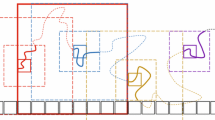Abstract
We consider finite range Gibbs fields and provide a purely combinatorial proof of the exponential tree decay of semi-invariants, supposing that the logarithm of the partition function can be expressed as a sum of suitable local functions of the boundary conditions. This hypothesis holds for completely analytical Gibbs fields; in this context the tree decay of semi-invariants has been proven via analyticity arguments. However the combinatorial proof given here can be applied also to the more complicated case of disordered systems in the so-called Griffiths' phase when analyticity arguments fail.
Similar content being viewed by others
REFERENCES
L. Bertini, N. Cancrini, and F. Cesi, The spectral gap for a Glauber-type dynamics in a continuous gas, Ann. Inst. H. Poincaré Probab. Statist. 32:91–108 (2001).
L. Bertini, E. N. M. Cirillo, and E. Olivieri, Renormalization group transformations under strong mixing conditions: Gibbsianness and convergence of renormalized interactions, J. Statist. Phys. 97:831–915 (1999).
L. Bertini, E. N. M. Cirillo, and E. Olivieri, Graded cluster expansion for lattice systems, preprint (2003).
L. Bertini, E. N. M. Cirillo, and E. Olivieri, Renormalization group in the uniqueness region: Weak Gibbsianity and convergence, preprint (2003).
L. Bertini, E. N. M. Cirillo, and E. Olivieri, Randomly perturbed strong mixing systems: Beating Griffiths' singularity above the critical temperature, in preparation.
M. Cassandro and E. Olivieri, Renormalization group and analyticity in one dimension: A proof of Dobrushin's theorem, Comm. Math. Phys. 80:255–269 (1981).
R. L. Dobrushin and S. B. Shlosman, Completely analytical Gibbs fields, Statist. Phys. and Dyn. Syst. (Birkhauser, 1985), pp. 371–403.
R. L. Dobrushin and S. B. Shlosman, Completely analytical interactions constructive description, J. Statist. Phys. 46:983–1014 (1987).
M. Duneau, D. Iagolnitzer, and B. Souillard, Decrease properties of truncated correlation functions and analyticity properties for classical lattices and continuous systems, Comm. Math. Phys. 31:191–208 (1973).
M. Duneau, D. Iagolnitzer, and B. Souillard, Strong cluster properties for classical systems with finite range interaction, Comm. Math. Phys. 35:307–320 (1974).
M. Duneau and B. Souillard, Cluster properties of lattice and continuous systems, Comm. Math. Phys. 47:155–166 (1977).
J. Fröhlich and J. Z. Imbrie, Improved perturbation expansion for disordered systems: Beating Griffiths' singularities, Comm. Math. Phys. 96:145–180 (1984).
J. Glimm and A. Jaffe, Quantum Physics. A Functional Integral Point of View, 2nd edn. (Springer-Verlag, New York, 1987).
R. Kotecký and D. Preiss, Cluster expansion for abstract polymer models, Comm. Math. Phys. 103:491–498 (1986).
F. Martinelli and E. Olivieri, Approach to equilibrium of Glauber dynamics in the one phase region I. The attractive case, Comm. Math. Phys. 161:447–486 (1994).
F. Martinelli, E. Olivieri, and R. Schonmann, For 2-D lattice spin systems weak mixing implies strong mixing, Comm. Math. Phys. 165:33–47 (1994).
E. Olivieri, On a cluster expansion for lattice spin systems: A finite size condition for the convergence, J. Statist. Phys. 50:1179–1200 (1988).
E. Olivieri and P. Picco, Cluster expansion for D-dimensional lattice systems and finite volume factorization properties, J. Statist. Phys. 59:221–256 (1990).
D. Ruelle, Statistical Mechanics: Rigorous Results (Benjamin, New York/Amsterdam, 1969).
R. H. Schonmann and S. B. Shlosman, Complete analyticity for 2D Ising completed, Comm. Math. Phys. 170:453–482 (1995).
A. N. Shiryaev, Probability (Springer-Verlag, New York, 1996).
B. Simon, The Statistical Mechanics of Lattice Gases, Vol. I (Princeton University Press, Princeton, NJ, 1993).
H. Spohn, Equilibrium fluctuations for interacting Brownian particles, Comm. Math. Phys. 103:1–33 (1986).
Author information
Authors and Affiliations
Rights and permissions
About this article
Cite this article
Bertini, L., Cirillo, E.N.M. & Olivieri, E. A Combinatorial Proof of Tree Decay of Semi-Invariants. Journal of Statistical Physics 115, 395–413 (2004). https://doi.org/10.1023/B:JOSS.0000019813.58778.bf
Issue Date:
DOI: https://doi.org/10.1023/B:JOSS.0000019813.58778.bf



